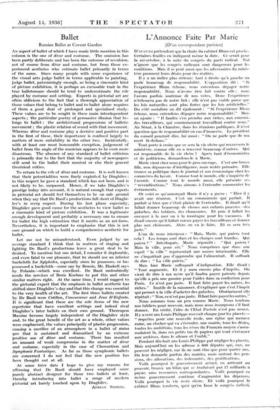Ballet
Russian Ballet at Covent Garden
AN aspect of ballet of which I have made little mention in this column is the one of decor and costume. The omission has been partly deliberate and has been the outcome of revulsion, not of course from decor and costume, but from those ex- perienced aesthetes who estimate ballet primarily in terms of the same. Since many people with some experience of the visual arts judge ballet in terms applicable to painting, judge ballet, patronisingly enough, as being a cinematic kind of picture exhibition, it is perhaps an excusable trait in the true balletomane should he tend to underestimate the role played by costume and setting. Experts in pictorial art are often oblivious to the fact that a thorough appreciation of those values that belong to ballet and to ballet alone requires of them a good deal of prolonged and specialised study. These values are to be sought in three main interdependent aspects ; the particular poetry of persuasive illusion that be- longs to ballet : the architectural progressions of balletic movement : the plastic relation of sound with that movement. Whereas decor and costume play a decisive and positive part in the first of these, their importance is confined largely to matters of mere suitability in the other two. Incidentally, with at least one most honourable exception, judgement of ballet from the angle of the musician appears to be even more disastrous. The absence of any standard of ballet criticism is primarily due to the fact that the majority of newspapers still send to the ballet their musical or else their general theatrical critics.
To return to the role of decor and costume. It is well known that their potentialities were finely exploited by Diaghilev : in this respect he gave a standard which has not been, and is not likely to be, surpassed. Hence, if we take Diaghilev's prestige today into account, it is natural enough that experts in pictorial art should feel themselves to be on safe ground when they say that De Basil's productions fall short of Diaghi- lev's in every respect. During his last phase especially, Diaghilev gave good cause for the aesthetes to view ballet as a cinematic kind of picture exhibition. It was a legitimate enough development and probably a necessary one to ensure for ballet the high estimation that it merits as an art-form. Nevertheless, it is important to emphasise that this is not sure ground on which to build a comprehensive aesthetic for ballet.
Let me not be misunderstood. Even judged by an average standard I think that in matters of staging and lighting De Basil's productions leave a great deal to be desired.' To mention but one detail, I consider it deplorable, and even fatal to our pleasure, that he should use an inferior backcloth for Sylphides, especially since he possesses, or has possessed a backcloth—some say by Benois, Mr. Haskell says by Polunin--which was excellent. De Basil undoubtedly needs the services of Boris Koehn° to put this and other similar matters right. At the same time, I would suggest to the pictorial expert that the emphasis in ballet aesthetic has shifted since Diaghilev's day and that this change was essential to the very health of the art. The first three ballets created by De Basil were Cotillon, Concurrence and Jeux D'Enfants. It is significant that these are the sole items of the new repertoire that have excellent settings and indeed rival Diaghilev's later ballets on their own ground. Thereupon Massine became largely independent of the Diaghilev style and, to the great benefit of the art as a whole, other values were emphasised, the values principally of plastic progression, causing a sacrifice of an atmosphere in a ballet of status quo that is sustained and dramatised by an extreme positive use of decor and costume. There has resulted an amount of weak compromise in the matter of decor and costume, especially in the case of Choreartium and Symphonic Fantastique. As far as those symphonic ballets are concerned I do not feel that the new position has been thought out at all.
At some later date I hope to give my reasons for affirming that De Basil should have employed some purely abstract designer for those two ballets at least, thereby introducing into ballet a range of modern pictorial art barely touched upon by Diaghilev.
ADRIAN STOKES.






































 Previous page
Previous page